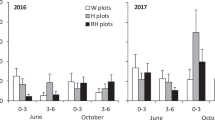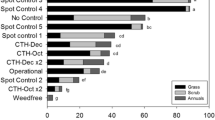Abstract
In the United States, the US EPA has the responsibility for the registration of pesticides. For the protection of nontarget terrestrial plants this requires two simple greenhouse tests (seedling emergence and vegetative vigor), each done with ten species grown individually. Indications of unacceptable effects levels equivalent to environmental exposure can lead to field testing which is not well-defined. Our objective was to develop a regional field test that is simple, economical, geographically flexible and with endpoints of ecological significance and compare the results with the standard greenhouse tests. Three native Oregon plant species were grown together with an introduced species. The experiment was replicated at two locations and repeated for 3 years with glyphosate applied at 0, 0.01 (8.3 g/ha), 0.1 (83.2 g/ha), and 0.2 (166.4 g/ha) × FAR (Field Application Rate of 832 gm/ha acid equivalent) and 2 years with aminopyralid applied at 0, 0.037 (4.6 g/ha), 0.136 (16.7 g/ha), and 0.5 (61.5 g/ha) × FAR (123 g/ha acid equivalent). With glyphosate, plant height and volume decreased with increasing herbicide concentration for all species, and for nearly all farm × year combinations. With aminopyralid, one species died at nearly all concentrations, sites and years, while the effects on the other three species were less pronounced and variable. The relative rank in glyphosate sensitivity among species in the field studies differed from the ranking from greenhouse studies, with Cynososurs echinatus the most sensitive in the field but Prunella vulgaris the most sensitive in the greenhouse. With aminopyralid, sensitivity generally was similar for all species in the greenhouse as in the field. The results suggest that a simple field test can be successfully designed to investigate the ecological effects of herbicides on plant communities and supplement information gained from greenhouse tests performed in controlled environments.








Similar content being viewed by others
References
Bidelspach C, Olszyk D, Pfleeger T (2008) Can artificial soil be used in the vegetative vigor test for us pesticide registration? Integr Environ Assess Manag 4:409–415
Boutin C, Freemark KE, Keddy CJ (1995) Overview and rationale for developing regulatory guidelines for nontarget plant testing with chemical pesticides. Environ Toxicol Chem 14:1465–1475
Boutin C, Elmegaard N, Kjaer C (2004) Toxicity testing of fifteen non-crop species with six herbicides in a greenhouse experiment: implications for risk assessment. Ecotoxicology 13:349–369
Boutin C, White AL, Carpenter D (2010) Measuring variability in phytotoxicity testing using crop and wild plant species. Environ Toxicol Chem 29:327–337
Carpenter D, Boutin C (2010) Sublethal effects of the herbicide glufosinate ammonium on crops and wild plants: short-term effects compared to vegetative recovery and plant reproduction. Ecotoxicology 19:1322–1336
Clark J, Ortego L, Fairbrother A (2004) Sources of variability in plant toxicity testing. Chemosphere 57:1599–1612
Dalton RL, Boutin C (2010) Comparison of the effects of glyphosate and atrazine herbicides on nontarget plants grown singly and in microcosms. Environ Toxicol Chem 29:2304–2315
Damgaard C, Mathiassen SK, Kudsk P (2008) Modeling effects of herbicide drift on the competitive interaction between weeds. Environ Toxicol Chem 27:1302–1308
Fletcher JS, Johnson FL, Mc Farlane JC (1990) Influence of greenhouse versus field testing and taxonomic differences on plant sensitivity to chemical treatment. Environ Toxicol Chem 9:769–776
Fletcher JS, Muhitch MJ, Vann DR, Mc Farlane JC, Benenati F (1985) PHYTOTOX database evaluation of surrogate plant species recommended by the U.S. Environmental Protection Agency and the Organization for Economic Cooperation and Development. Environ Toxicol Chem 4:523–532
Fletcher JS, Pfleeger TG, Ratsch HC (1993) Potential environmental risks associated with the new sulfonylurea herbicides. Environ Sci Technol 27:2250–2252
Fletcher JS, Pfleeger TG, Ratsch HC, Hayes R (1996) Potential impact of low levels of chlorsulfuron and other herbicides on growth and yield of nontarget plants. Environ Toxicol Chem 15:1189–1196
Freemark K, Boutin C (1995) Impacts of agricultural herbicide use on terrestrial wildlife in temperate landscapes: a review with special reference to North America. Agric Ecosyst Environ 52:67–91
Grove B, Power A, Buckley GP, Ghazoul J (2007) Effects of herbicide spray drift and fertilizer overspread on selected species of woodland ground flora: comparison between short-term and long-term impact assessments and field surveys. J Appl Ecol 44:374–384
Kjaer C, Strandberg M, Erlandsen M (2006a) Metsulfaron spray drift reduces fruit yield of hawthorn (Crataegus monogyna L.). Sci Total Environ 356:228–234
Kjaer C, Strandberg M, Erlandsen M (2006b) Effects on hawthorn the year after simulated spray drift. Chemosphere 63:853–859
Kleijn D, Snoeijing GIJ (1997) Field boundary vegetation and the effects of agrochemical drift: botanical change caused by low levels of herbicide and fertilizer. J Appl Ecol 34:1413–1425
Marrs RH, Frost AJ (1997) A microcosm approach to the detection of the effects of herbicide spray drift in plant communities. J Environ Manag 50:369–388
OECD (2006a) Test No. 208: terrestrial plant test: seedling emergence and seedling growth test, OECD guidelines for the testing of chemicals, section 2: effects on biotic systems. OECD Publishing. doi:10.1787/9789264070066-en
OECD (2006b) Test No. 227: terrestrial plant test: vegetative vigour test, OECD guidelines for the testing of chemicals, section 2: effects on biotic systems. OECD Publishing. doi:10.1787/9789264067295-en
Olszyk D, Blakeley-Smith M, Pfleeger T, Lee EH, King G, Plocher M, Kern J (2006) Use of vegetative vigor test to detect effects of low levels of herbicides on selected non-crop plants. Research Report. EPA/600/R-06/117. U.S. Environmental Protection Agency, Corvallis
Olszyk D, Pfleeger T, Lee EH, Burdick C, King G, Plocher M, Kern J (2008) Selecting and evaluating native plants for region-specific phytotoxicity testing. Integr Environ Assess Manag 4:105–117
Olszyk D, Pfleeger T, Lee EH, Plocher M (2009) Pea (Pisium sativum) seed production as an assay for reproductive effects due to herbicides. Environ Toxicol Chem 28:1920–1929
Olszyk D, Pfleeger T, Lee EH, Plocher M (2010) Potato (Solanum tuberosum) greenhouse tuber production as an assay for asexual reproduction effects from herbicides. Environ Toxicol Chem 29:111–121
Pfleeger T, Olszyk D, Burdick C, King G, Kern J, Fletcher J (2006) Using geographic information system to identify areas for potential off target pesticide exposures. Environ Toxicol Chem 25:2250–2259
Pfleeger T, Olszyk D, Plocher M, Yilma S (2008) Effects of low concentrations of herbicides on full-season, field-grown potatoes. J Environ Qual 37:2070–2082
Pfleeger T, Olszyk D, Lee EH, Plocher M (2011) Effects of low levels of herbicides on potatoes (Solanum tuberosum L.) soybeans (Glycine max L.) and peas (Pisum sataivum L.) grown in a greenhouse and outside. Environ Toxicol Chem 30:455–468
Riemens M, Dueck T, Kempenaar C (2008) Predicting sublethal effects of herbicides on terrestrial non-crop plant species in the field from greenhouse data. Environ Pollut 155:141–149
Science Advisory Panel (2001) Review of non-target plant toxicity plant tests under the North American Free Trade Agreement (NAFTA). Final Report. FIFRA Scientific Advisory Panel (SAP), Washington, DC
Touart LW, Maciorowski AF (1997) Information needs for pesticides registration in the United States. Ecol Appl 7:1086–1093
US EPA (1982) Pesticide assessment guidelines subdivision J. hazard evaluation: Nontarget plants. EPA 540/9-82-020. Office of Pesticides
US EPA (1991) In: Flecher J, Rasch H, Corvallis OR (eds) Plant tier testing: a workshop to evaluate nontarget plant testing in subdivision J pesticide guidelines. EPA/600/9-91/041
US EPA (1996b) Ecological effects test guidelines. OPPTS 850.4150 Vegetative Vigor, Tier I. EPA 712-C-96-163, Washington, DC
US EPA (1996c) Ecological effects test guidelines. OPPTS 850.4225 Seedling Emergence, Tier II. EPA 712-C-96-363, Washington, DC
US EPA (1996d) Ecological effects test guidelines. OPPTS 850.4250 Vegetative Vigor, Tier II. EPA 712-C-96-364, Washington, DC
US EPA (1996e) Ecological effects test guidelines. OPPTS 850.4300 Terrestrial Plants Field Study, Tier III. EPA 712-C-96-155, Washington, DC
US EPA (United States Environmental Protection Agency) (1996a) Ecological effects test guidelines. OPPTS 850.4100 Seedling Emergence, Tier I. EPA 712-C-96-153, Washington, DC
White AL, Boutin C (2007) Herbicidal effects on nontarget vegetation: investigating the limitations of current pesticide registration guidelines. Environ Toxicol Chem 26:2634–2643
White AL, Boutin C, Dalton RL, Henkelman B, Carpenter D (2009) Germination requirements for 29 terrestrial and wetland wild plant species appropriate for phytotoxicity testing. Pest Manag Sci 69:19–26
Acknowledgments
The authors thank Henry Miller, Melvin Larson and Tamotsu Shiroyama from the Senior Environmental Employee program of the National Asian Pacific Center; Marjorie Storm, Gail Heine, and Fred Senecal of Dynamac Corporation; EPA summer student Thomas Griffin, Oregon State University student intern Conor Bidelspach, and Greater Research Opportunity summer students Megan Butler and Alexander Ramsower for their valuable assistance in carrying out these experiments. The authors also thank Connie Burdick EPA for editorial assistance and Patricia DeCastro of CSC for the figures. Thanks to Celine Boutin for reviewing an earlier version of this manuscript and offering suggestions on its improvement. The information in this document has been funded wholly (or in part) by the U.S. Environmental Protection Agency under contract numbers 68-D-01-005, EP-D-06-013 and EP-D-11-027 to Dynamac Corporation. It has been subjected to review by the National Health and Environmental Effects Research Laboratory’s Western Ecology Division and approved for publication. Approval does not signify that the contents reflect the views of the Agency, nor does mention of trade names or commercial products constitute endorsement or recommendation for use.
Author information
Authors and Affiliations
Corresponding author
Rights and permissions
About this article
Cite this article
Pfleeger, T., Blakeley-Smith, M., King, G. et al. The effects of glyphosate and aminopyralid on a multi-species plant field trial. Ecotoxicology 21, 1771–1787 (2012). https://doi.org/10.1007/s10646-012-0912-5
Accepted:
Published:
Issue Date:
DOI: https://doi.org/10.1007/s10646-012-0912-5




